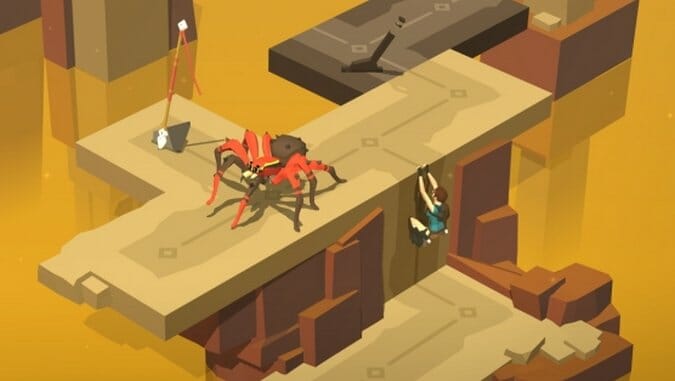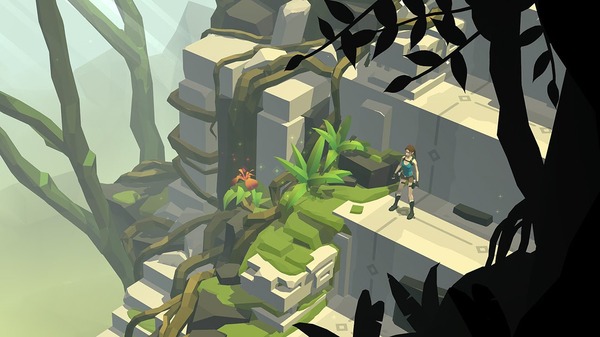
Lara Croft is all over the place these days. I don’t mean that her image is ubiquitous as the marketing grows ever more intense for her upcoming console outing (although that’s certainly true), but rather that Lara as a character has splintered, refracting into multiple versions of herself that come to represent different sorts of games, different flavors, different canons. You have New Lara, the console blockbuster darling, who pilfered ideas and themes from Nathan Drake and Marcus Fenix to create a gritty adventure with pickaxe-to-the-neck executions and over-the-top setpieces. You have Co-Op Lara, who shows up in Guardian of Light and Temple of Osiris, cracking jokes and mowing down hordes and hordes of enemies alongside ancient Mayan warriors and Egyptian demigods. And you have Lara Croft™, Lara the Brand, who can be conveniently applied atop any game to give it that Tomb Raider flavor, whether that game is a Temple Run clone or the more cerebral Lara Croft GO. Fortunately, like its console sibling Tomb Raider, Lara Croft GO borrows the right ideas from the right contemporaries and arranges them in a package that, if not wholly original, is really quite slick.
Lara Croft GO is a puzzle game that shares the same conceit as Square Enix’s previous GO title Hitman GO—you move around a board-game-like path or grid, dodging or destroying enemies, pulling levers, raising platforms, moving pillars, and manipulating your environment until you open the path to the exit. Each puzzle is generally a single screen in size, and though later levels have as many as five screens to them, the system of checkpoints ensures that you never have to retrace too many of your steps if you fail. Deaths happen quickly (and involve none of the gruesome, cringe-worthy stuff that filled the console Tomb Raider), and reload times are quick, so there’s very little penalty for failure, which reduces frustration greatly. The puzzles get quite complicated and satisfying by the end, but they take a long time ramping up in difficulty—I was probably two-thirds of the way through the game’s three-hour-or-so playtime before I really had to put on my thinking cap. Still, the game feels good to play, and there’s considerable joy to be had simply in traversing the environments. The game’s simplicity might be best conveyed by the fact that the game has almost no text—no dialogue, no narration, no tutorial.
Though Lara Croft GO abandons the board-game aesthetic of Hitman GO (perhaps that game’s most notable quality), it instead picks some truly great games to ape: the low-poly visuals with their bright, solid colors seem aimed in the general direction of Monument Valley, probably one of the most beautiful mobile games of the last ever, and in at least a handful of Lara Croft GO’s scene transitions I felt sure that some devs at Square Enix Montreal were big fans of Kentucky Route Zero. Whereas Monument Valley presented the player with Escherian architecture that revolved and unfolded like treasure boxes, taking hard right angles and making them transformative and fluid, Lara Croft GO achieves something like the opposite, taking a host of organic, dynamic things and turning them into cogs in a murderous machine—snakes will strike if you are directly in front of them, giant spiders will march inexorably back and forth, carnivorous lizards will follow exactly two steps behind you once you enter their field of vision. Even Lara, who from her very first incarnation has circle-strafed predators and navigated ruins with acrobatic grace, becomes a cog: she moves one square at a time, just like every other part of the machine. It doesn’t feel very much like Tomb Raider, but it has its own kind of rhythm, and it’s certainly engaging to swipe your phone’s screen and have eight pieces (Lara, an Indiana-Jones-style boulder, two giant spiders, and four whirring buzzsaws) move in concert.
This didn’t need to be a Lara Croft game, but it’s a very solid game nonetheless. It’s concise, clean, pretty and satisfying—and though it’s over rather quickly, that just means that it doesn’t overstay its welcome. If, going forward, Lara’s going to be synonymous with stealing stuff from those who’ve come before, well… I suppose that’s just appropriate, isn’t it?
Lara Croft GO was developed by Square Enix Montreal and published by Square Enix. It is available for Android and iOS.
Nate Ewert-Krocker is a writer and a Montessori teacher who lives in Atlanta. His first book, an adventure novel for teens, is available here. You can find him on Twitter at @NEwertKrocker, where he mostly gushes about final boss themes from JRPGs.
